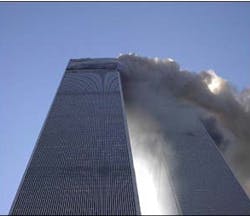WTC Picture Shows FDNY Moments Before The Worst
In the picture, the steel facade World Trade Center’s north tower gleams in the bright sunshine. Polished Engine 10 is connected to a fire hydrant and other engines are lined along the street. Several people including two in helmets and bunker coats look up to the sky. They seem to be studying something but there is little hint in the body language of an impending crisis.
The picture is a moment in time that illustrates the saying, "If you think it’s bad now, just wait". When looking at it there is an urge to shout at the people to get out of there. It was bad, real bad, and then it got worse.
FDNY EMS Paramedic Michael Glenn took the picture. His wife awakened him just after the first plane crashed into the World Trade Center. In five minutes he was out the door of his Brooklyn home and 16 minutes later he was at ground zero checking in with a command center in a garage entrance across the street from North Tower #1.
Glenn parked his car and found the command post where he reported in although he was not on duty that day. But at that time and place there was nothing to do. He took his camera out and snapped a couple of pictures.
He decided to go back to check on his car and was about 100 feet from the command post when the first tower came down. There was no warning. There was no thought this would happen. "I would not have been taking these pictures if we thought this was coming down," Glenn said.
And now things were different. Rescuers were dying. Glenn believes the two men in helmets are Deputy Fire Commissioner Thomas Fitzpatrick on the left and Deputy Fire Commissioner William Feehan on the right. Feehan was lost in the tragedy. "I think it is the last picture taken of Feehan," Glenn said. "Some went left and some went right. Some lived and some died."
Glenn dashed into the World Financial Center and raced far to the back. Along with eight or nine police officers and lobby security people they waited.
Moving out of the building again, he found an EMS Chief who asked him if he was attached to anyone. When he said no, the Chief said, "good, you are now in charge of triage," and he set up a triage center in the Embassy Suites Hotel lobby. There wasn’t much time there until reports came in that the second tower was wobbling. He rushed to get people moved again and ended up jumping into the back of an ambulance. "I just hoped I wouldn’t get squished," he said.
Over the next 20 hours he worked ground zero and the triage center at Chelsea Piers. At first there were some victims he said. Then they stopped coming in. He spent his time treating other rescue workers for the injuries the incurred while scrambling to find other victims.
Somewhere between the first and second tower collapses, he called his wife to tell her he was OK. She had helped him pull his gear together as he was rushing to leave the house. He has four children. When he saw the television pictures he knew what he would do. "I wasn’t going to miss this. How could I not go," Glenn said.
In the picture, where fire trucks and firemen are primed to deal with the unthinkable, there is no question of their readiness to do what needed to be done. But at that moment they did not know the price they would pay.
Glenn has been with FDNY EMS since 1995. Including the two paramedics lost that day, eight close friends of his died in the tragedy.
